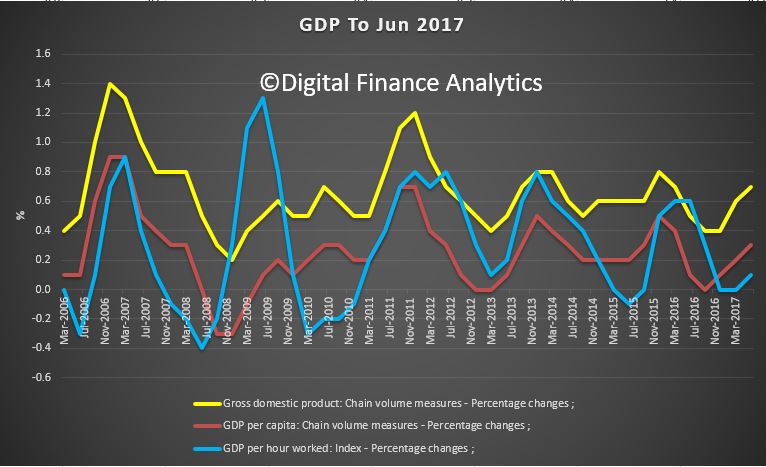Data from the Australian Bureau of Statistics (ABS) shows the Australian economy grew by 0.8 per cent in seasonally adjusted chain volume terms during the June quarter. This is below expectations. Household consumption figure was pretty solid, but at the expense of the household savings ratio dipped which dipped to 4.6%, (5.3% in March). As a result, the current savings ratio is lowest since 2008, thanks to weak, very weak, wages growth.
Domestic spending increased 1.0 per cent for the quarter, driven by a 0.7 per cent growth in household consumption, with expenditure on food, clothing and household furnishings increasing. Dwelling construction grew a moderate 0.2 per cent with growth being observed in New South Wales and Queensland.
Growth was also observed in industries providing services to business. Professional, Scientific and Technical Services, Financial and Insurance Services, and Information, Media and Telecommunications all recorded above trend growth. The Manufacturing industry grew 1.8 per cent.
Falling prices for key export commodities impacted the terms of trade in the June quarter, declining 6.0 per cent. This has impacted GDP in current prices, which fell 0.1 per cent as lower coal and iron ore prices contributed to more subdued company profits. Gross operating surplus from businesses declined 2.6 per cent for the quarter.
GDP growth for the 2016 -17 financial year was 1.9 per cent.
Chief Economist for the ABS, Bruce Hockman said: “Recent swings in coal and iron ore prices have had significant effects on the Australian economy in terms of export revenues and real incomes, though export volumes continued to grow in the June quarter. Dwelling construction remains at elevated levels, although new residential building approvals are on the decline. ”
Mr Hockman said: “Recent indicators showing increased business confidence appear to be reflected by the 3.2 per cent quarterly increase in purchases of new machinery and equipment as well as increases in the previously published June quarter employment and hours worked estimates.”
The increases in hours worked resulted in an increase in Compensation of Employees (COE) of 0.7 per cent despite the subdued wage pressures in the economy. This moderate increase in COE coupled with the strong increase in household spending saw the percentage of income which households are saving fall to 4.6 per cent.


One thought on “Economy grows 0.8 per cent in June quarter”